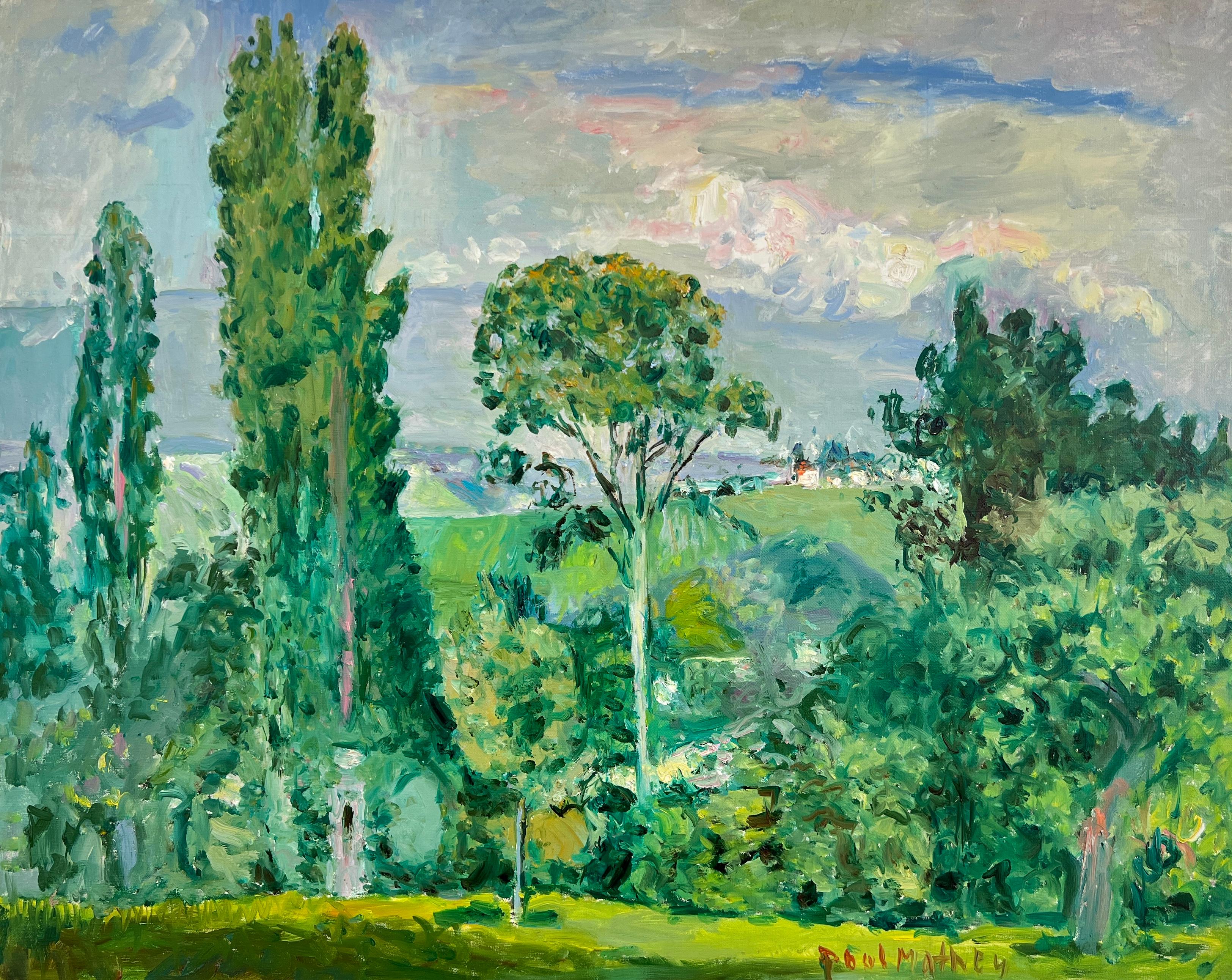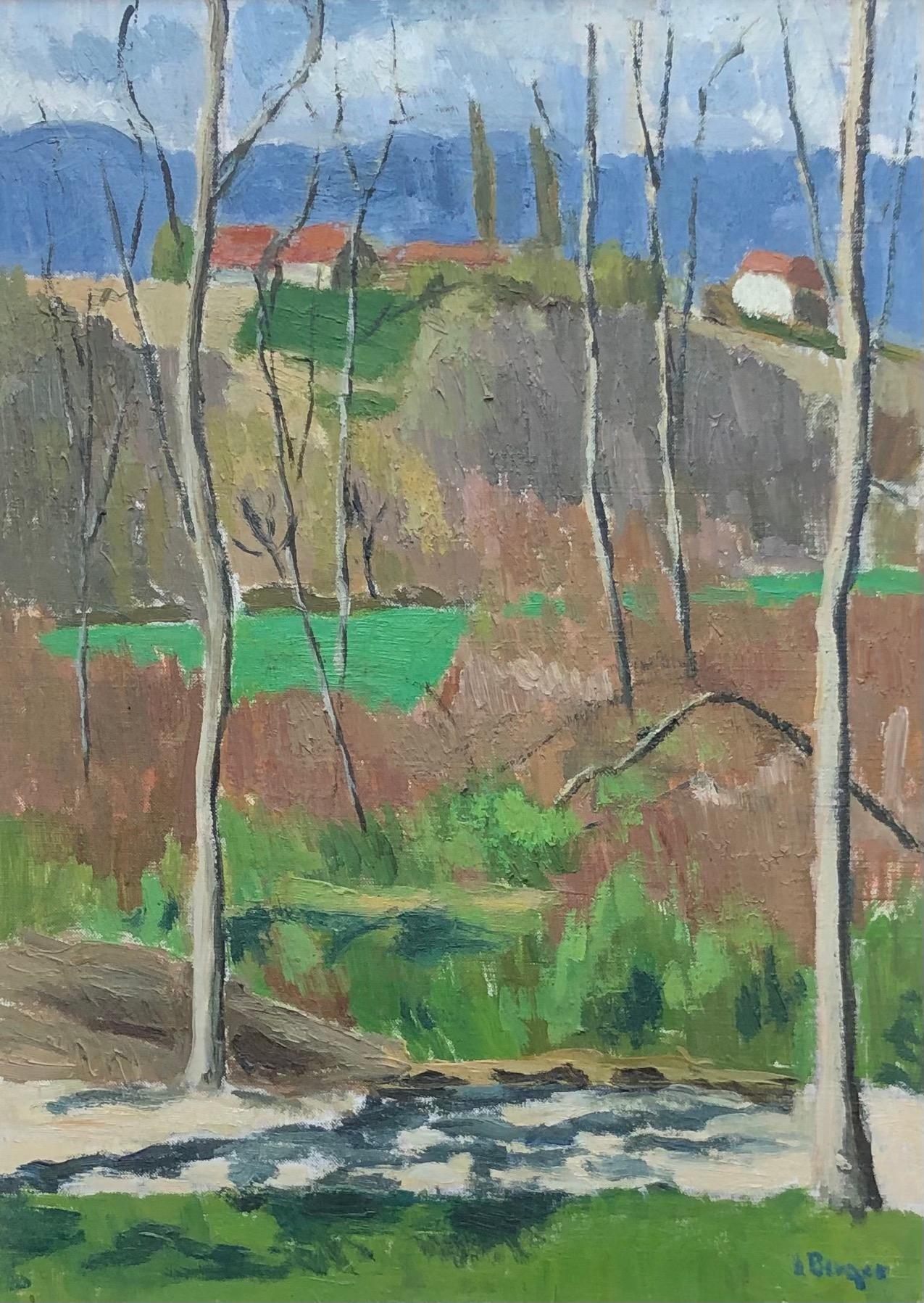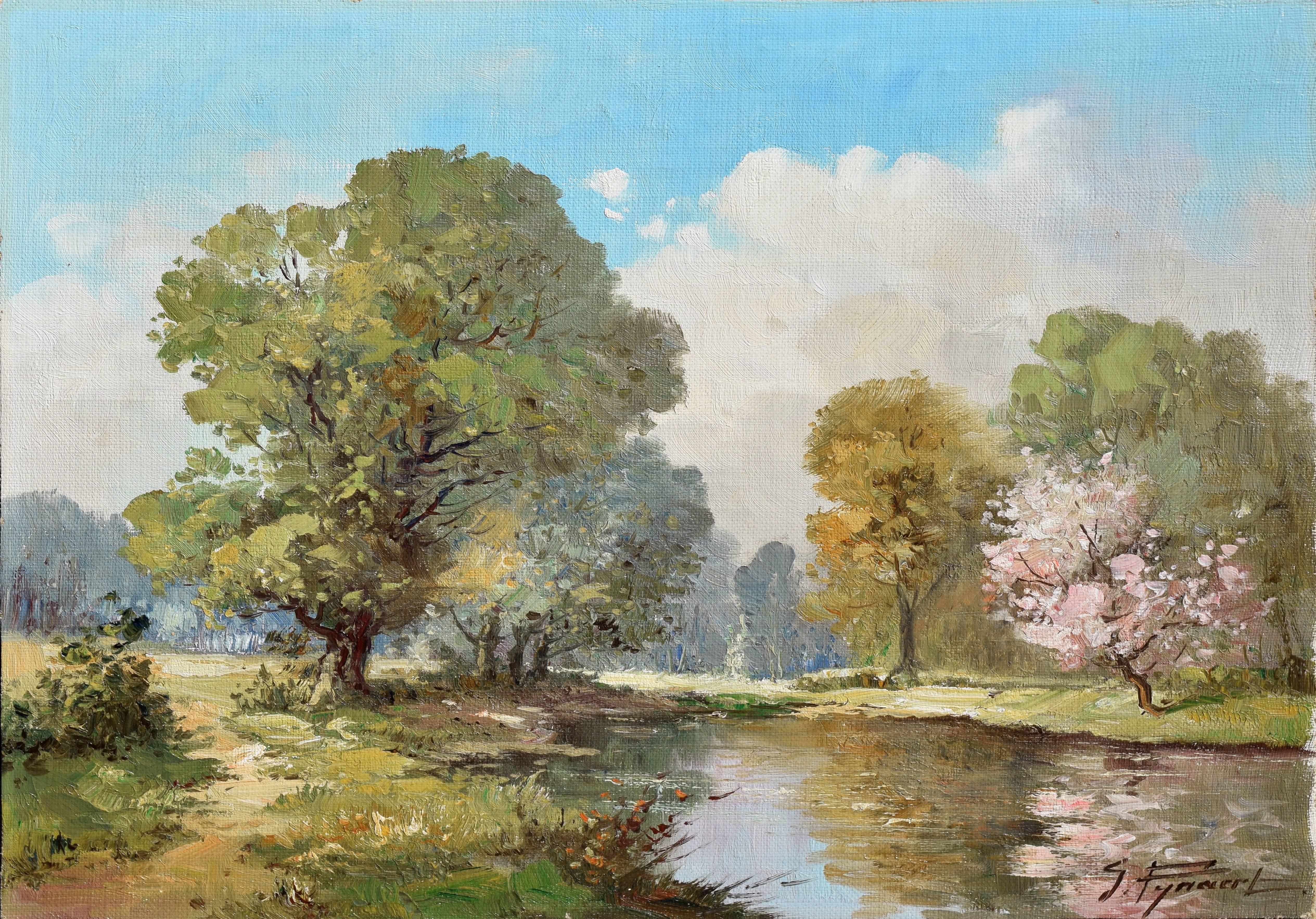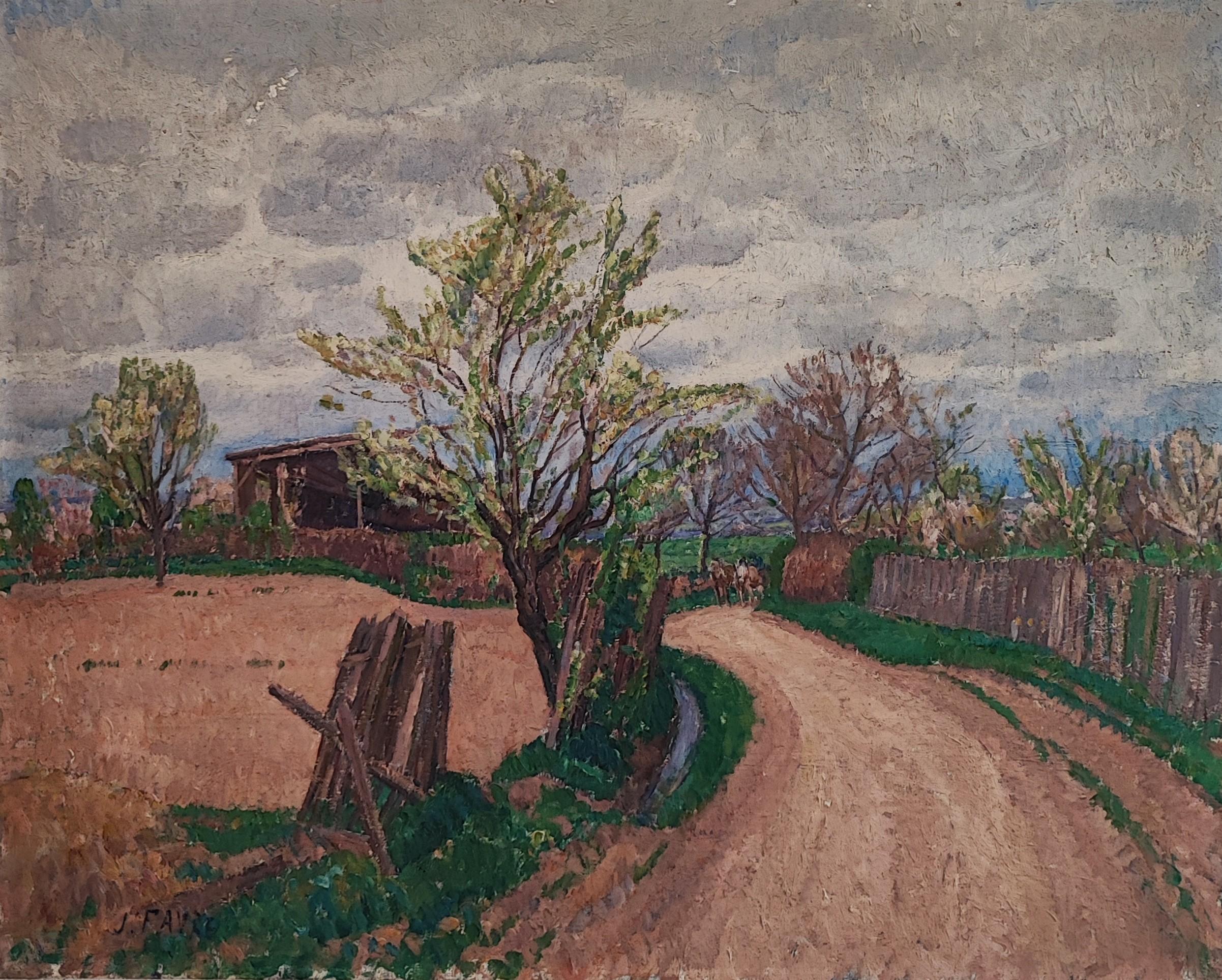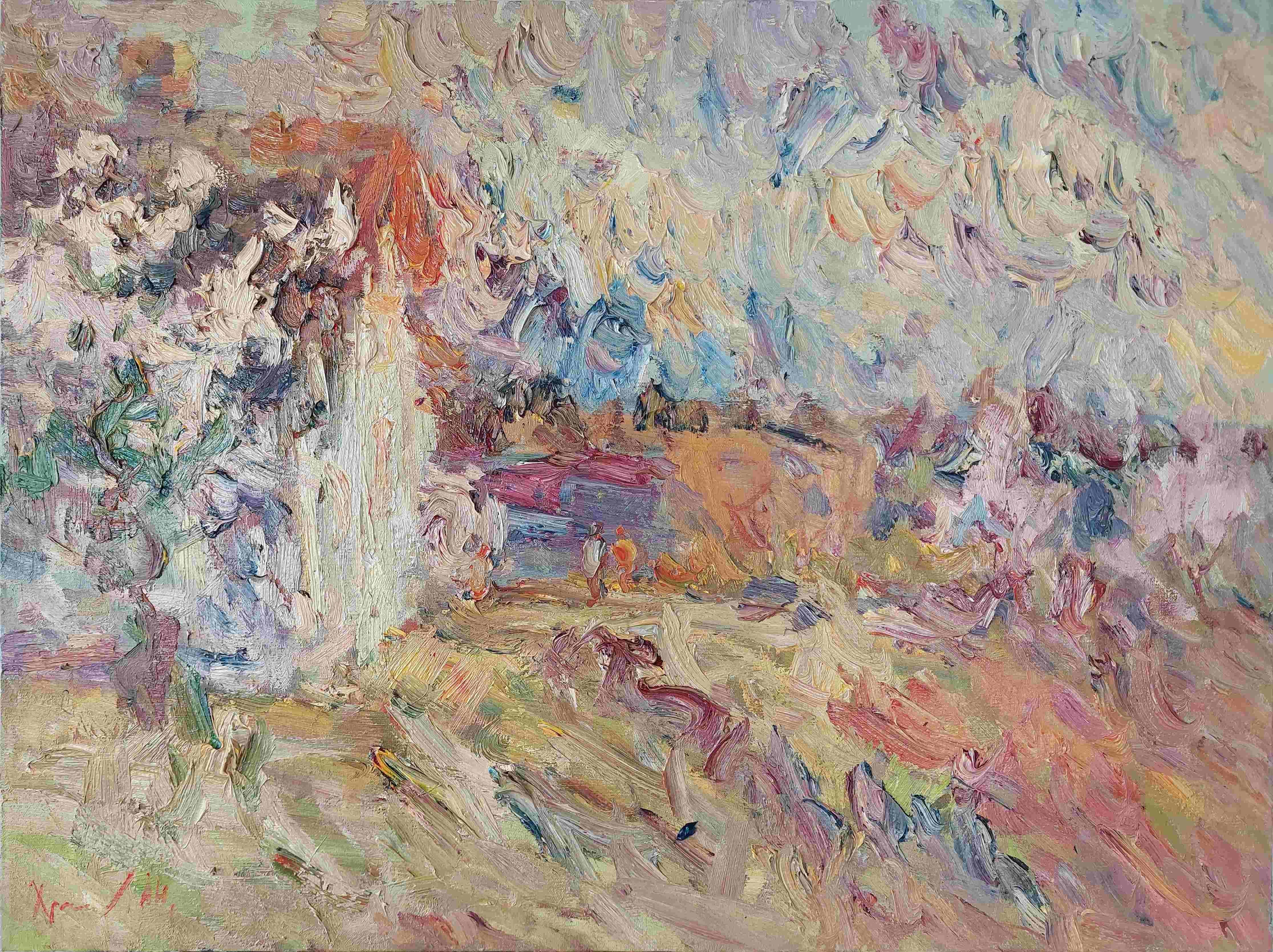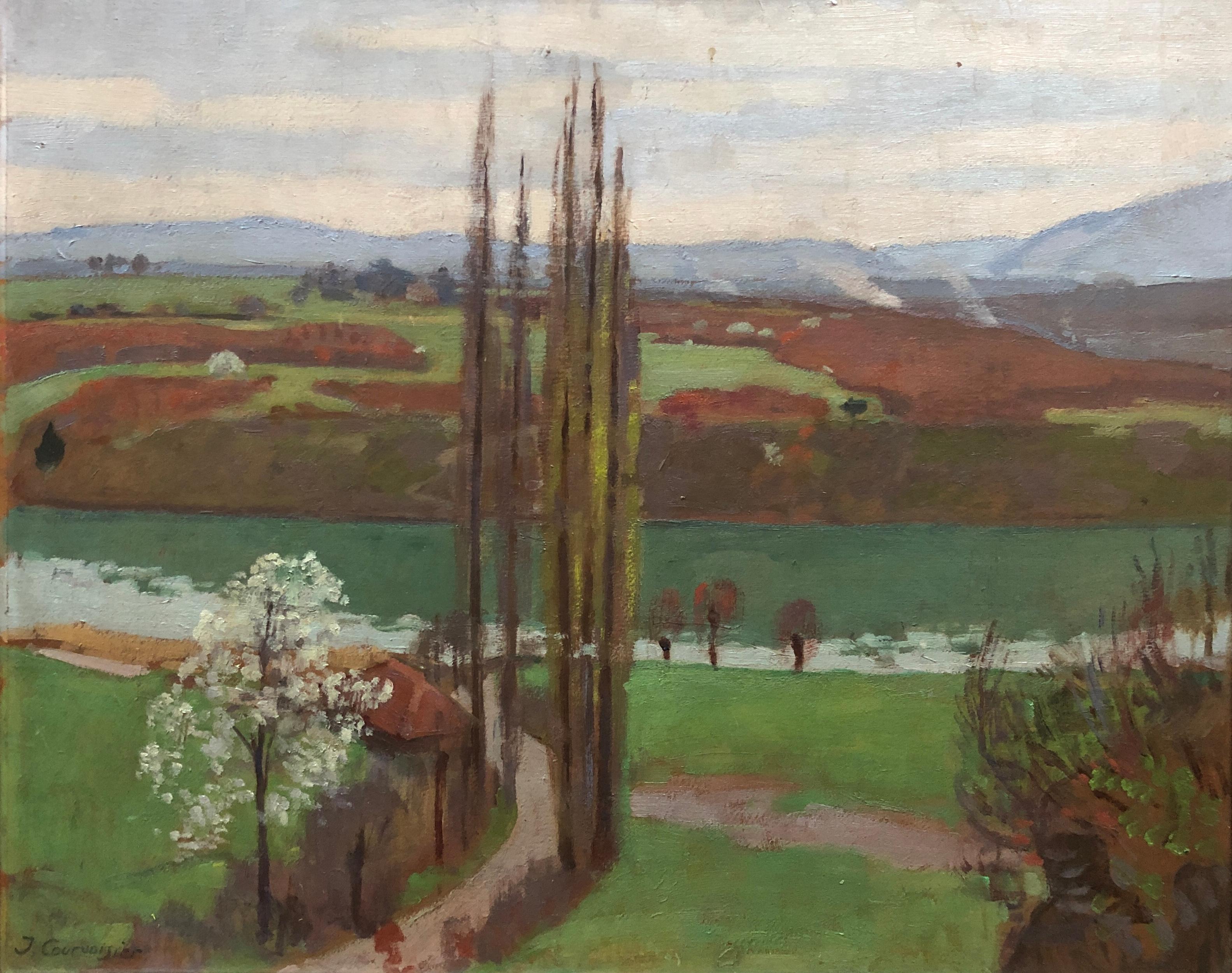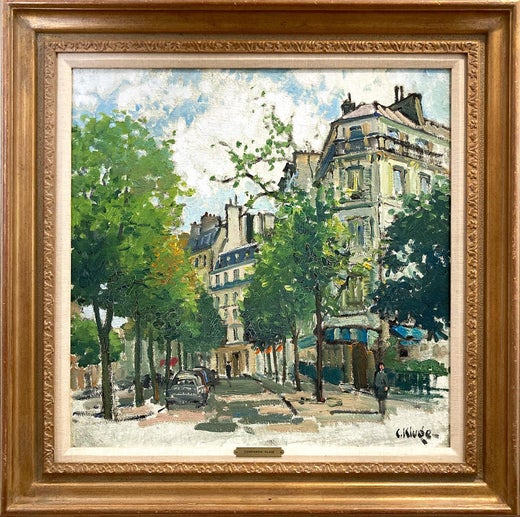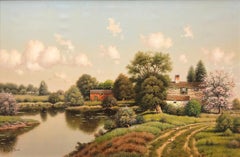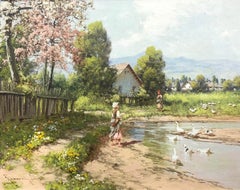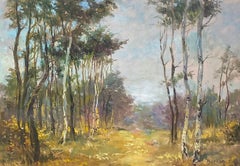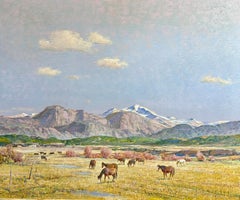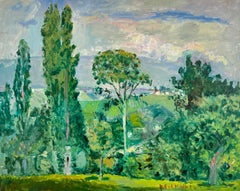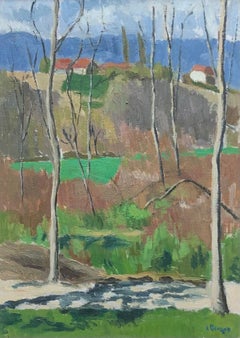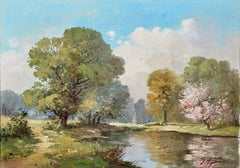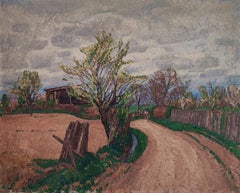Video Loading
Want more images or videos?
Request additional images or videos from the seller
1 of 10
Constantin KlugeSpring
Price Upon Request
Price Upon Request
Price Upon Request
Price Upon Request
Price Upon Request
Price Upon Request
Price Upon Request
Price Upon Request
Price Upon Request
Price Upon Request
About the Item
Spring
Constantin Kluge (Russian, Latvian, 1912-2003)
Signed Lower Right
29.5 x 36.5 inches
36.5 x 44 inches framed
He was born in Riga, Latvia, on January 29, 1912 to Russian parents.
His father was a graduate of the Polytechnic Institute of Riga and his mother a Professor of Literature. Kluge's father was drafted into the Czar's army in 1914. Then the chaos of the 1917 Bolshevik Revolution and the ensuing Civil War completely uprooted the family.
They moved frequently, always eastward, arriving in Manchuria in 1920. Here the little boy learned to speak Mandarin. In 1925 the émigré family moved again, this time to the French "concession" of Shanghai, where Kluge would graduate from the French Municipal High School.
By the time he was seventeen, he was a very active member of the Shanghai Art Club. At this period of his life he also took up the violin and cello, and later in Paris gave music lessons to help meet his expenses. Meanwhile, his parents had decided that pure art was not a dependable career, and so in 1931 Kluge left Shanghai for Paris to study architecture. He spent six years at the E'cole des Beaux-Arts and in 1937 graduated with the title of French Government Architect.
The years spent studying and living in the Latin Quarter of Paris had created in Kluge a strong attachment to the characteristic scenes of Paris, and, instead of returning immediately to Shanghai and his family, he stayed on in Paris for six months painting views of Paris in oils, purely to portray and preserve the scenes he so loved. The childhood years spent in the Orient had contributed to his love of painting.
His professor of Chinese had taught him, from the age of ten, a respect for the handling of the brush, and the attitude of the Orientals toward the beauties of nature drew the young artist to the depiction of beauty and away from the vogue for the ugly and sordid in painting. When Kluge returned to China, he practiced his profession of architecture for a time. But when his friends persuaded him to exhibit his paintings, the exhibitions were so successful and aroused such enthusiasm that Kluge felt that painting, his first love, could afford him a livelihood. Kluge spent the years of World War 11 in Shanghai convinced that he avoided trouble with the Japanese occupiers only because of the respect and love the Japanese people have for painting.
In mid-1946 he accepted an architectural post in Hong Kong and continued to paint in his spare time. In March, 1950, amid rumors that the Chinese Communists might invade Hong Kong, Constantin Kluge left Asia for good and returned to his beloved Paris. Already a mature and successful painter by the time he reached Paris, it is not surprising that he won an award and considerable attention at the Paris Salon in 1951. Since that time he was a frequent exhibitor in the Salon shows, which proved to be his gateways to ever increasing public attention. Kluge was a member of the Societe' des Artistes Francais, and his works won prizes at their Salon. In 1961 he was awarded the Medaille d'Argent as well as the special Raymond Perreau prize given by the Taylor Foundation at the Salon.
In 1962 he received the coveted Gold Medal of the Salon. In 1990, Kluge earned one of the most prestigious non-military awards bestowed by the French government: he was named a Chevalier de la Legion d'Honneur by the French Ministry of Culture. In 1991, Kluge was awarded the Grand Medal of the City of Senlis. Completely captivated by the many moods of Paris, Kluge became absorbed in painting this beautiful city. The gaiety and animation of the flower markets; the subtly pensive and poetic quiet areas along the Seine; the special quality of Paris sunshine in early spring; the quaintness yet sophistication of Pairis are wonderfully expressed in his widely varied compositions. His fascination with Paris is contagious and the viewer feels drawn into each Kluge painting. In addition to Paris scenes, Kluge has sought out quiet, picturesque harbor scenes where the colors of water and sails blend to form softly modulated patterns of great beauty and interest. As with his paintings along the Seine, Kluge's handling of water in these harbor scenes is unusually lovely and convincing.
Probably due to his early architectural training, Kluge has in the past been primarily occupied with subjects which include buildings of many types, but pure landscape subjects intrigued him as well. In his country scenes of provincial France, where sunlight and changing atmospheric qualities present a new challenge, Kluge used the same subtlety and sensitive rendering of beauty found in his other work. It is interesting to find this capable painter rounding out his repertoire in such varied fashion. While Kluge continued to paint, he ws also a writer of considerable stature. His autobiography, Constantin Kluge (published in 1987), details his fascinating life and includes many color reproductions of his paintings.
French art critics have declared that Constantin Kluge was a painter of poetic realism. Kluge painted without affectation, in a frank and straightforward style. His firm drawing and well-constructed forms are bathed in an atmosphere of subtle colors. He enjoyed painting and communicated that joy to the beholder.
- Creator:Constantin Kluge (1912 - 2003, French)
- Dimensions:Height: 29.5 in (74.93 cm)Width: 36.5 in (92.71 cm)
- Medium:
- Movement & Style:
- Period:
- Condition:
- Gallery Location:Missouri, MO
- Reference Number:1stDibs: LU747314223872
Constantin Kluge
Constantin Kluge was a Russian-born French painter best known for his naturalistic scenes of Paris and French countryside in a style reminiscent of Albert Marquet. Kluge was born to a wealthy military family on January 29, 1912 in Riga, Latvia, which was then a large, industrial Russian port city. He spent much of his childhood and young adult life between Manchuria, Beijing, and Hong Kong, where he discovered a love for brush and ink painting. Kluge studied architecture at the École des Beaux Arts in Paris and earned his diploma in 1937. Upon graduating, he painted the city’s river banks and streets before returning to Shanghai. With the rise of Communism in China, the artist fled to Paris in 1950 and began exhibiting in the French Salons. He was a success both artistically and financially. Of his many awards, he received the Gold Medal, Salon des Artistes Francais and was made Chevalier de la Legion d’Honneur by the French Government. He died on January 9, 2003 in Paris, France.
About the Seller
5.0
Vetted Professional Seller
Every seller passes strict standards for authenticity and reliability
Established in 1970
1stDibs seller since 2017
155 sales on 1stDibs
Typical response time: 1 to 2 days
- ShippingRetrieving quote...Shipping from: Missouri, MO
- Return Policy
Authenticity Guarantee
In the unlikely event there’s an issue with an item’s authenticity, contact us within 1 year for a full refund. DetailsMoney-Back Guarantee
If your item is not as described, is damaged in transit, or does not arrive, contact us within 7 days for a full refund. Details24-Hour Cancellation
You have a 24-hour grace period in which to reconsider your purchase, with no questions asked.Vetted Professional Sellers
Our world-class sellers must adhere to strict standards for service and quality, maintaining the integrity of our listings.Price-Match Guarantee
If you find that a seller listed the same item for a lower price elsewhere, we’ll match it.Trusted Global Delivery
Our best-in-class carrier network provides specialized shipping options worldwide, including custom delivery.More From This Seller
View AllSpringtime at the Farm
Located in Missouri, MO
George W. Drew (1875-1968)
"Springtime at the Farm"
Oil on Canvas
24 x 36 inches (site)
31.5 x 43.25 (framed)
George W. Drew was born 21 December 1875 in Massachusetts. He was a member of the Independent Artists Association. He exhibited at the National Academy of Design and they have him recorded as living at 745 Columbus Ave., N.Y. in the year 1898. He also exhibited at the Allied Artists of America, which was established in 1914, Salons of America, N.Y. State Fair, Newark State Fair, Newark Museum and New York Museum of Science & Industry.
Although there is little known about the personal life of George W. Drew, his paintings appear on the art market quite often. It is obvious that his work has always been well received because of the numerous exhibitions he has participated in. He is known for his rustic luminous depictions of the Nineteenth Century American Landscape. Like many of the Hudson River Painters...
Category
Early 20th Century American Impressionist Landscape Paintings
Materials
Canvas, Oil
Price Upon Request
Tending the Flock
By Laszlo Neogrady
Located in Missouri, MO
Laszlo Neogrady (1896-1962)
"Tending the Flock" c. 1930
Oil on Canvas
approx 24 x 30
approx 30 x 36 framed
Laszlo Neogrady was born in Budapest, Hungary in 1896. He was the son of...
Category
Early 20th Century Land Landscape Paintings
Materials
Canvas, Oil
Price Upon Request
Lonesome Woods
By Mark Kaplan
Located in Missouri, MO
Landscape
By Mark Kaplan (Russian, b. 1950)
Signed Lower Right
Unframed 7" x 9"
Framed: 20.25" x 16.25"
Mark Kaplan was born in 1950 in Saint Petersburg ...
Category
20th Century Impressionist Landscape Paintings
Materials
Paper, Oil
Price Upon Request
Winter Pasture
By Oscar Edmund Berninghaus
Located in Missouri, MO
Oscar E. Berninghaus (American, 1874-1952)
"Winter Pasture"
Oil on Canvas
Unframed: 20 x 24 inches
Framed: 25.5 x 29.5 inches
Provo: Noonan-Kocian Gallery, St. Louis, Missouri, Dec. 23, 1954 (Copy of Original Receipt Included)
* Will be included in Kodner Gallery's upcoming Oscar E. Berninghaus Research Project on the artist
A founder in 1898 of the Taos Society of Artists, Oscar Berninghaus excelled at drawing animals and figures in contemporary garb in Southwestern landscapes. Many of his early paintings were Impressionistic, "suffused with color and light". (Gerdts 254)
He was born in St. Louis, Missouri and developed an interest in art through his family's lithography business. He attended night classes at the St. Louis School of Fine Art. In 1898, he was on an illustration assignment for "McClure's" magazine, which took him for the first of many times into New Mexico and Arizona. He had heard of the special beauty of Taos and there met Bert Geer Phillips, who was already a resident, and Phillips invited him to return.
This visit began a tradition of spending the winter months in St. Louis and the summers in Taos. He remained active in both communities, and for many years designed the costumes and floats for the Veiled Prophet parade, a famous annual event in St. Louis.
He also did a series of western scenes commissioned by the Anheuser-Busch Brewing Association to promote a manly, ruggedness theme in their products and to enhance their image as good Americans, an image that was being attacked by suffragettes. In this capacity and without visiting the area, Berninghaus did a painting titled "Old Faithful, Yellowstone" in 1914, which was used as a calendar illustration in the series.
Berninghaus was a sketch artist for the Denver and Rio Grande Railroad to depict landscape of Colorado...
Category
Early 20th Century Abstract Impressionist Landscape Paintings
Materials
Canvas, Oil
Price Upon Request
Autumn II
By Samuel Hyde Harris
Located in Missouri, MO
By the great California Impressionist, Sam Hyde Harris.
Image Size: 12 x 16 inches
Framed Size: 14.25 x 18 inches
Signed and Titled Verso
At 14 years...
Category
1930s American Impressionist Landscape Paintings
Materials
Oil, Board
Price Upon Request
River Access
By Joseph Orr
Located in Missouri, MO
Joseph Orr (Japanese, American, b. 1949)
River Access
Signed Lower Right
30 x 30 inches
39.5 x 39.5 inches with frame
BORN in Tokyo, Japan, Oct 31,1949, Joseph lived his first years in an orphanage sponsored by American Armed Forces. He was adopted April,1954 and came to the US at age 5 where he became an American citizen. As the Orr’s traveled for the US military Joseph enjoyed a childhood rich in experiences from Germany and back to California where he attended High School and started College.
Following his parents to Missouri In 1971 he took a job with Hallmark Cards as machine operator in the cardboard fold dept. It sparked an interest in art, so after a few months he sought out some of the Hallmark artists at their work for private lessons. He learned basic drawing and watercolor from Anthony Allison and, “Probably before I was ready”, he admits, Joseph was entering local art shows and even winning prizes. At that time Joseph also enrolled for art instruction under John Coleman at Longview Community College. He spent one semester there.
By the end of 1972 Joseph had quit his day job to become a full time painter, joining an art show tour group called Word Of Art, which was a new concept: culture meets promotion. Booking weekly art exhibits in the new indoor shopping malls across America, The idea transformed part of the art world by bringing art to the masses.
For Joe and many other artists in the early 1970’s, it created the chance to paint full time and sell their work to an otherwise unobtainable audience. During this time of continuous self study and painting Joseph transitioned from watercolor to the newer acrylic painting medium.
Believing that acrylic, as a fine art painting medium, can be as viable as oil, Orr has always promoted it as the modern medium that it is.
In 1990 Joseph, along with his wife, Rita and two other artists, founded the National Oil & Acrylic Painter’s Society. The Orr’s brainchild, they were aided in founding NOAPS organization by local art patrons, Wm & Martha Mitchell and fellow artists Pete Peterson and Dennis T. Yates.
While traveling with the World of Art Tour Joseph had met Rita Mathews, an aspiring artist, in Columbia, MO. They were married in June 1974 and stayed in Missouri, traveling and exhibiting their art together. Orr had a brief encounter with printmaking in 1977. He took private instruction in stone lithography and copper plate etching from Frank Stack, professor of art at the Univ of MO, Columbia, but painting remained his principal devotion.
By 1999 Joseph had become proficient enough to have obtained Gallery representation with several Fine Art Galleries across the US.
Joseph Orr currently resides in Osage Beach, Missouri, but travels to paint and visit his gallery representatives and Exhibit Openings.
PHILOSOPHY:
For me the idea is that painting should follow some form of illustration and truth telling. Basically, the premise of my painting philosophy, is to build layers of narrative into my paintings. A place or landscape scene is never defined satisfactorily without it’s relationship to color and composition. It is important to balance fact with imagination.
“ART REFLECTS THE SOUL OF SOCIETY. A JUDGMENT CAN BE MADE FOR THE ATTITUDE OR CONDITION OF SOCIETY BY INSPECTING THE POPULAR ‘IDEAS’ OF ART OR, IN SOME INSTANCES, THE LACK OF ART.” (JOSEPH C. ORR)
NOTED SOLO EXHIBITS :
*BIRGER SANDZEN MEMORIAL, LINDSBORG, KS;
*HARWELL ART MUSEUM, POPLAR BLUFF, MO;
*ASHBY-HODGE GALLERY OF AMERICAN FINE ART, FAYETTE, MO;
*NORFOLK ART CENTER, NORFOLK, NE;
*KODNER GALLERIES...
Category
20th Century Contemporary Landscape Paintings
Materials
Canvas, Acrylic
$10,000
You May Also Like
Spring
By Paul Mathey
Located in Genève, GE
Work on canvas
Category
Early 20th Century Landscape Paintings
Materials
Oil
$1,785
First spring
Located in Genève, GE
Work on canvas
Golden wooden frame
63 x 49.5 x 3.5 cm
Category
Mid-20th Century Landscape Paintings
Materials
Oil
Mid Century Belgium in Spring Landscape
By Gustav Pynaert
Located in Soquel, CA
Gorgeous mid-century Belgian landscape by Gustav Pynaert (Belgium, 1900-1968), c.1950. Signed lower right. Unframed. Image size: 16"H x 20"L.
Gustave Pynaert was born in Menen in West Flanders...
Category
1950s Impressionist Landscape Paintings
Materials
Canvas, Oil, Cardboard
$1,180 Sale Price
20% Off
Spring in Bernex
Located in Genève, GE
Work on canvas
Category
Early 20th Century Modern Landscape Paintings
Materials
Oil
Spring
Located in Edinburgh, GB
The painting "SPRING" by Oleksandr Khrapachov is a true hymn to the revival of nature. Spring on this canvas is not just a season of changing weather, but a dynamic moment when natur...
Category
21st Century and Contemporary Impressionist Landscape Paintings
Materials
Canvas, Oil
Countryside spring landscape and Jura
Located in Genève, GE
Work on cardboard
Golden wooden frame
45 x 53 x 4 cm
Self-portrait of the artist on the back of the work
Category
Early 20th Century Landscape Paintings
Materials
Oil
More Ways To Browse
Mid Century Chinese Landscape Painting
Taylor Vintage Landscape
French Flower Market Oil
La Vogue Vintage
Vintage Japanese China Patterns
Vintage Japanese Water Flowers
Medaille D Argent
Cello Form
Joy Taylor
Occupied Japan China
Boy With Violin
Painting Of Lighthouse
Post Modern Flower Paintings
Harold Brown
Paintings Of Rockport
Swamp Art
Carmel Art Association Paintings
Dorset Painting
